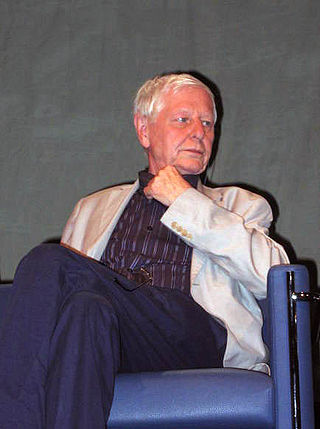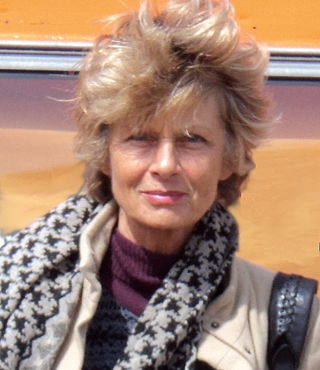
The Spaßguerilla or Spaßgerilja was a grouping within the student protest movement of the 1960s in Germany that agitated for social change, in particular for a more libertarian, less authoritarian, and less materialistic society, using tactics characterized by disrespectful humour and provocative and disruptive actions of a minimally violent nature. Events organized by the groups included actions such as attacking politicians or the police with custard pies.

Uwe Johnson was a German writer, editor, and scholar. Such prominent writers and scholars as Günter Grass and Hans Mayer declared Johnson to be the most significant writer to emerge from East Germany. During the 1950s, he had troubles with the East German authorities, being treated as a "dissident" both for political reasons and for Modernist experiments in his works which made him opposed to the dominant doctrine of Socialist realism; after moving to West Berlin in 1959, he gained the label of "the author of the two Germanies", as, while criticizing East Germany as the state which betrayed the Socialist ideals, he didn't regard West Germany as a viable alternative and opposed the division of Germany in general. His works were dedicated both to East and West German societies and examined the relations between them.

Moabit is an inner city locality in the borough of Mitte, Berlin, Germany. As of 2022, about 84,000 people lived in Moabit. First inhabited in 1685 and incorporated into Berlin in 1861, the former industrial and working-class neighbourhood is fully surrounded by three watercourses, which define its present-day border. Between 1945 and 1990, Moabit was part of the British sector of West Berlin and directly bordered East Berlin.

Hans Magnus Enzensberger was a German author, poet, translator, and editor. He also wrote under the pseudonyms Andreas Thalmayr, Elisabeth Ambras, Linda Quilt and Giorgio Pellizzi. Enzensberger was regarded as one of the literary founding figures of the Federal Republic of Germany and wrote more than 70 books, with works translated into 40 languages. He was one of the leading authors in Group 47, and influenced the 1968 West German student movement. He was awarded the Georg Büchner Prize and the Pour le Mérite, among many others.

The West German student movement, sometimes called the 1968 movement in West Germany, was a social movement that consisted of mass student protests in West Germany in 1968. Participants in the movement later came to be known as 68ers. The movement was characterized by the protesting students' rejection of traditionalism and of German political authority which included many former Nazi officials. Student unrest had started in 1967 when student Benno Ohnesorg was shot by a policeman during a protest against the visit of Mohammad Reza Pahlavi, the Shah of Iran. The movement is considered to have formally started after the attempted assassination of student activist leader Rudi Dutschke, which sparked various protests across West Germany and gave rise to public opposition. The movement created lasting changes in German culture.
The Sozialistische Deutsche Studentenbund — the Socialist German Students' Union or Socialist German Students' League — was founded in 1946 in Hamburg, Germany, as the collegiate branch of the Social Democratic Party of Germany (SPD). In the 1950s, tensions between the SDS and the main party surfaced, particularly over the party's support of West Germany's rearming, until the SPD expelled all members of the SDS from the party in 1961.
Brigitte Margret Ida Mohnhaupt is a German convicted former terrorist associated with the second generation of the Red Army Faction (RAF) members. She was also part of the Socialist Patients' Collective (SPK). From 1971 until 1982 she was active within the RAF.
Amon Düül was a West German political art commune formed out of the student movement of the 1960s that became well known for its free-form musical improvisations. This spawned two rock groups: Amon Düül and the more famous Amon Düül II. After both groups disbanded in the 1970s, some of the original members reunited in the 1980s under the name Amon Düül again, though this incarnation is commonly referred to as Amon Düül UK to avoid confusion with earlier versions of the band.

Ursula "Uschi" Obermaier is a former fashion model and actress associated with the 1968 left-wing movement in Germany. She is considered an iconic sex symbol of the so-called "1968 generation" and the protests of 1968.

Eight Miles High is a 2007 German biographical motion picture, set in the 1960s and depicting the "wild life" of Uschi Obermaier, a West German sex symbol and icon of the era.

El Cimarrón is a scenic vocal composition by the German composer Hans Werner Henze, written when the composer lived in Cuba in 1969–1970. It is subtitled Biographie des geflohenen Sklaven Esteban Montejo, and the libretto by Hans Magnus Enzensberger is based on the oral autobiography related in 1963 to Miguel Barnet by Montejo, who was also a veteran of the Cuban War of Independence (1895–98).

The Tupamaros West-Berlin (TW) were a small German Marxist organization which carried out a series of bombings and arsons at the end of the 1960s. In 1969 Dieter Kunzelmann, Georg von Rauch, and a few others traveled to Jordan to train at a Fatah camp, forming the Tupamaros on their return to Germany. The group took their name from the Uruguayan Tupamaros. The TW had a core membership of about 15 people.

Dieter Kunzelmann was a German left-wing activist.

Fritz Teufel was a prominent figure in the West German political left of the 1960s. One of the founders of Kommune 1, Teufel cultivated a theatrical, humorous public image—encapsulated in his idea of the "Spaßguerilla". In the 1970s he rejected this image and became involved with the violent Movement 2 June. He was jailed several times in the 1960s and 1970s.

Anna Werner is a German photographer. She is, in particular, known for her membership of Der Harem - described variously as a "virtual commune" or a "self-discovery group" - around Rainer Langhans.

Brigitte Streubel is a German former photo-model, sometime actress and author. She is, in particular, known for her membership of Der Harem - described variously as a "virtual commune" or a "self-discovery group" - around Rainer Langhans.
pardon was a German satirical magazine, which appeared biweekly from 1962 to 1982. It was published to criticise the conservative situation of the Adenauer era.

The Blow Up (1967–1972) was a famous nightclub in Munich and Germany's first large-scale discotheque. During its existence, the nightclub was the favorite topic of magazines and daily newspapers because of countless happenings, drug stories and its psychedelic light projections. The British Pathé described the club as being "the hottest and most expensive happening center in West Germany. It's wild, it's way-out, it's with it, it's got everything."

Gisela Martine Getty is a German photographer, film director, designer, and author. She is known for her involvement in the German '68-movement, along with her late sister, Jutta Winkelmann.
The Frankfurt department store firebombings on 2 April 1968 in Frankfurt am Main were politically motivated arsons, in which the later co-founders of the left wing extremist Red Army Faction, Andreas Baader and Gudrun Ensslin were involved. Together with Thorwald Proll and Horst Söhnlein they set three fires, in two department stores at night and were sentenced to three years in prison each. No people were injured; the damage in the Kaufhaus M. Schneider was calculated at 282.339 DM and in the Kaufhof, 390.865 DM.















